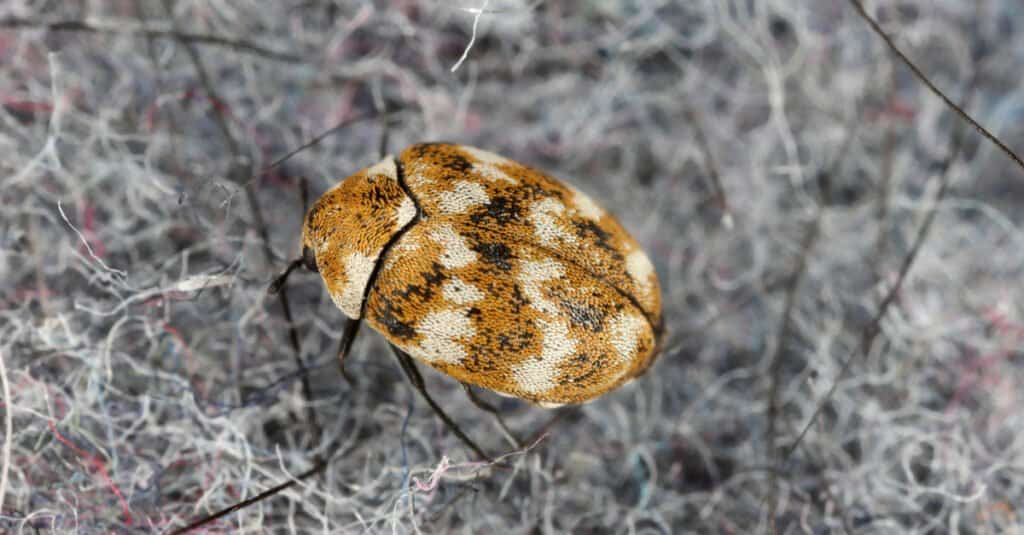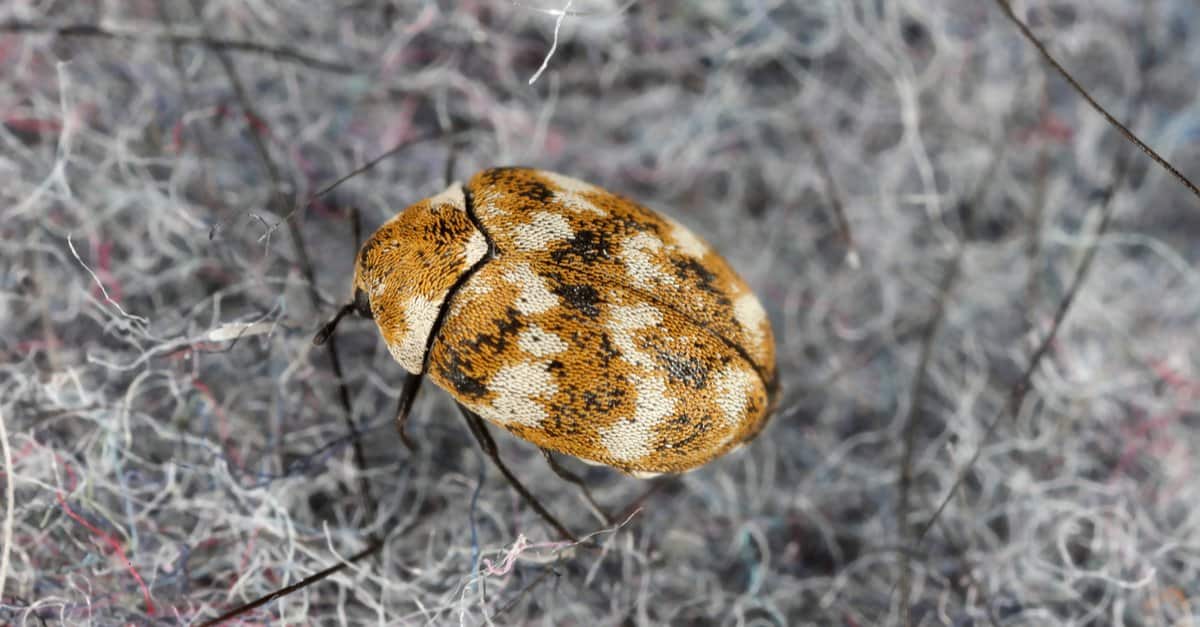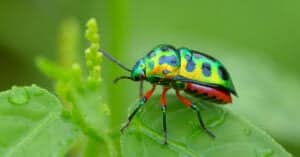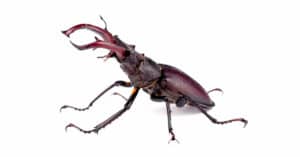Carpet beetles might not be the most immediately threatening pest in your home, but that doesn’t mean that they can’t be a real hassle. Because while they might not actively spread disease or leave you with a line of bug bites down your arm, it doesn’t mean that they can’t leave marks on your skin or threaten your property.
Carpet beetles can leave nasty marks behind, but the biggest threat they pose is to your clothing. If left unattended, the young can quickly chew through your entire wardrobe. And since they’re otherwise harmless, you might not even notice until it’s too late. Even worse, these attacks on clothing are often misdiagnosed as a moth infestation. Correct identification is crucial if you want your clothing to be safe and the problem resolved.
Here’s everything you need to know for the identification of a carpet beetle infestation along with all the treatment and prevention tips you can follow if you do notice the signs of infestation in your home.
How to Identify Carpet Beetles
Identification of carpet beetles is made trickier by the fact that there are three main types of carpet beetles with their own unique physical characteristics. And when you consider that the symptoms of a carpet beetle infestation are often mistaken for those of moths and that the carpet beetle looks quite similar to the notorious bed bug, it’s worth paying attention to the details. No matter what species you’re dealing with, you can expect adult carpet beetles to be a little smaller than bed bugs with an average size of less than a quarter inch. That makes them significantly smaller than a dime — and while they’re visible to the naked eye, they can be difficult to notice if you aren’t actively looking for them.
Carpet beetles also closely resemble bed bugs in terms of shape. Both bugs are flat and ovular, although carpet beetles can be distinguished by the fact that they have visible wings, whereas bed bugs have no wings at all. The best way to distinguish a carpet beetle may be by its coloring. While bed bugs are naturally a shade of dark brown and can appear more reddish after they’ve gorged on blood, the coloring of a carpet beetle depends primarily on the specifies of beetle that you’re dealing with.
Black carpet beetles are the easiest to identify since their shells are completely black. Common, varied, and furniture carpet beetles are a mottled combination of colors, though specific coloration can differ depending on the species. Fortunately, once you’ve completed the identification process, treatment and prevention are the same regardless of the species that you’re dealing with.

©Tomasz Klejdysz/Shutterstock.com
How to Identify Carpet Beetle Larvae
The facts show that carpet beetle larvae pose the biggest threat to your home, so you should also know how to identify them. Fortunately, they’re slightly larger than carpet beetles, and their bright colors make them generally easy to distinguish if you know the facts about them. Larvae are usually about a third of an inch in length and share a long and fuzzy body that makes them look like small caterpillars. But coloration can vary from one species to another.
Larvae of furniture carpet bugs begin their lives white but develop red bands and a red or chestnut base coloration as they mature. Varied carpet beetles alternate between dark and light stripes, while common carpet beetle larvae are reddish-brown with dark hairs. Black carpet beetle larvae are black or dark brown like the adult members of their species, and they distinguish themselves from other species by being hairless.
How to Identify Carpet Beetle Rashes
One of the reasons that carpet beetles can be so hard to detect is that they don’t bite as adults. But if there are carpet beetle larvae in your home, you may start to experience symptoms similar to a bite. Allergic reactions to the shed bristles of carpet beetle larvae aren’t uncommon — and these allergic reactions most commonly take the form of pink rashes on the skin. These rashes are usually visible, bright, and prone to itching.
That’s not the only allergic reaction people suffer from either. Carpet beetle larvae can also be associated with a runny nose, watery eyes, and issues with the gastrointestinal system. Allergic reactions typically only happen if larvae come in direct contact with your skin.
Carpet Beetle Rash vs Bed Bug Bites
Most people won’t have any allergic reaction to carpet beetles in their homes, so an absence of rashes isn’t in any way a definitive sign of an absence of carpet beetles. By contrast, most people will experience discomfort and irritation from bites if there are bed bugs in their homes. Fortunately, the facts make the identification of a bite or rash rather easy.
Bed bug bites also may take time to become apparent because these insects have a numbing feature in their saliva. This generally causes the bitten to not realize what has happened. However, some people have specific allergic reactions to the bed bug bites.
Both carpet beetle rashes and bed bug bites are characterized by splotchy and raised bits of reddened skin, and the severity can vary greatly in both. Most carpet beetle rashes will appear as small red dots on the skin, though severe allergic reactions may transform them into larger and non-uniform red splotches. Bed bug bites can take a while to become apparent, but you can identify the bites by the puncture marks at the center of any rashes. Bed bug bites will typically appear in a straight line or a zig-zag pattern, though they may also be clustered together.
If you can’t distinguish the signs of a carpet beetle rash from a bed bug bite, you might want to consult with a professional. You can also turn your attention to other signs of a bed bug infestation — like blood or rusty fecal stains on your sheets — for reliable identification.
How to Identify a Carpet Beetle Infestation
While the sudden appearance of bed bugs can usually be traced to a piece of used furniture brought into the home or an infestation from an adjoining apartment, carpet beetles tend to find new habitats of their own volition. Unfortunately, that means that vigilance is the best way to prevent larger issues from occurring — and that’s especially true since carpet beetles don’t bite and can easily go undetected for long periods. They’ll most often enter a home by flying through windows or crawling through cracks in the molding or underneath doors.
The most obvious symptoms of an infection can be seen in clothing, carpets, or bedding made from natural fibers. Carpet beetles will typically lay their eggs on carpets or along floorboards so that their larva will have a steady diet of fabric to grow to adulthood. While they won’t feast on synthetic products and typically avoid cotton, they can be a threat to everything from fur to silk to wool. You’re most likely to see adults out in the open since they prefer well-lit areas like window sills, but tracking down the larva that causes the real damage means looking for darker corners of your house with more readily available food sources.

©Tomasz Klejdysz/Shutterstock.com
How to Protect Your Home From Carpet Beetles
The best prevention methods for a carpet beetle infestation involve protecting your clothing. Any natural fabrics that are in storage or that you don’t see regularly should be placed in airtight containers to starve beetles of a food source, and any clothing going into storage for a long time should be professionally cleaned and dried to remove the presence of any eggs and the attractive smell of sweat and other human odors. You can make your home less attractive to these bugs by installing screens on your windows, sealing up any cracks that might give them access to your home, and removing spider webs and dead insects that can also serve as an attractive food source to beetles.
In many cases, treatment simply involves throwing out any clothing that might be compromised by the larvae and putting any clothing at risk into inaccessible storage. Also, be sure to thoroughly vacuum your home anywhere you might suspect an infestation. Be especially careful about carpets, floorboards, and heating vents as they’re some of the more popular locations for adult beetles to lay their eggs. In the case of a particularly stubborn infection, homeowners may want to try poisoning the bugs with boric acid or call on a pest management professional for more in-depth treatment methods.
Up Next:
- How To Get Rid of Carpet Beetles So now you know what they look like and if they bite, but do you know how do you get rid of the little guys?
- Beetle John, Paul, George, and Ringo? Nope! Just your average beetle!
- Find Out If Your Mattress Has Bed Bugs Another insect to worry about! Does your mattress have these critters?
Thank you for reading! Have some feedback for us? Contact the AZ Animals editorial team.








